#FertilityGod
Explore tagged Tumblr posts
Text
An epic battle between the deities of Pre-Islamic Arabian Mythology and Basque Mythology.
You find yourself in the midst of a colossal battle between the gods of Pre-Islamic Arabian mythology and the deities of Basque mythology. The air crackles with supernatural energy as the two sides clash in a fierce and deadly struggle. As you look around, you see a bewildering array of gods and goddesses locked in combat. On one side, you see the legendary Arabian figures like Allah, Baal,…

View On WordPress
#Aide#Allah#AlLat#AlUzza#ArabianGods#Baal#BasqueDeities#BasqueMythology#DeadlyStruggle#DivineEnergy#DivineFire#EpicStruggle#FertilityGod#FierceBattle#Galtzagorri#GodsBattling#Hubal#LegendaryArabianFigures#MagicalFlames#Manat#Mari#PreIslamicArabianMythology#Retaliation#SeafaringDiety#Sin#StormGod#Sugaar#SupernaturalEnergy#WarGoddess#WarringDeities
0 notes
Text
two word URL ideas for Perse:
Springpiety
Seedwrath
Fertilitygod
Springwrcth
Goddesseed
6seeds
That's all I can think of right now
0 notes
Text

✨It's FRIGGA or FREYJA'S Day! This Goddess is the source of today's name! Also related to her brother FREYR or Ingwaz! Both are siblings & Rulers over the Fairy kingdoms (this includes Elves & more)! Many words beginning with F originate with these Fertility Deities! Frigga tells me now those who had a good day owe this disir & get brother (pictured) thanks! Frigga's Rune is Berkano (Letter B). I have made all 24 Runes etched in the 3 oldest European languages! The originals were stolen and molds destroyed. Purchase ALL or just a few + I will make them anew just for you! Then others will be able to purchase again! (You get the credit!) Also pictured is 2 of my larger pendants! 🌷🔥🌟💥⚡☀️✨ I have been trying to rebuild all my jewelry & art that was stolen when I was assaulted & robbed (many times). I am looking for a quality SPIRITUAL STORE or ART GALLERY to TRULY help with sales/marketing their work & mine! I am a rare, tireless entertainer, salesperson and psychic. I have huge internet reach and can work day and night continuously! I don't even need to eat. I have got by on hard work & skill alone, not cheating & it shows! If you would like to make a connection happen contact me. If it works out I will pay you! 🌟 A very modest GoFundMe here! Please spread the word! https://gofund.me/82ac1c5b Thank you!🌟💜🗽💜🎿💜❄️💜🦌 🔥⚡👽🌟🦋👑🌷 . . . . . . . #elves #fairies #naturespirits #freyja #greenman #earthgoddess #witchcraft #spiritualart #runes #norse #freyr #paganism #magick #pagansofinstagram #spells #pagan #wicca #mothernature #heathen #ingwaz #celtic #wizard #germanic #druid #mythology #ritual #norse #shamanism #reincarnation #germanic #fertilitygod #fairyking http://dlvr.it/T0V5z7
0 notes
Photo

The wacky & wonderful at the @alamedaantiquesfaire #alamedaantiquesfaire #wacky #weird #wonderfull #antiques #rare #collectibles #wellhung #showernotagrower #statue #fertilitygod https://www.instagram.com/p/Ca0BCgFvvj0/?utm_medium=tumblr
#alamedaantiquesfaire#wacky#weird#wonderfull#antiques#rare#collectibles#wellhung#showernotagrower#statue#fertilitygod
1 note
·
View note
Photo

Giant kokopeli. A fertility deity venerated by some people’s indigenous to the American southwest. He also presides over agriculture and music. . . . . . #kokopeli #deity #fertilitygod #fertilitydeity #agriculturegod #godofagriculture #godofmusic #americansouthwest #fluteplayer #indigenousculture #indigenousart (at Scottsdale, Arizona) https://www.instagram.com/p/CLehbl2HMWG/?igshid=3xftvwci96ov
#kokopeli#deity#fertilitygod#fertilitydeity#agriculturegod#godofagriculture#godofmusic#americansouthwest#fluteplayer#indigenousculture#indigenousart
0 notes
Photo

* 23rd of April Celebrations * *Festival of The Green Man, the ancient God of Fertility, of the forest, flock, field and also of the hunt. He is the Giver of Life and also the Lord of Death and resurrection* #greenman #hornedgod #fertilitygod #forestgod #ancientgod #thegreenman #greenmanfestival #april23 #celticgod #wiccangod #trees #birds #forest #illustration #wickedandlovelystore
#forestgod#birds#ancientgod#wiccangod#celticgod#illustration#trees#fertilitygod#greenmanfestival#forest#greenman#hornedgod#wickedandlovelystore#thegreenman#april23
7 notes
·
View notes
Photo

Taranis, the Celtic god of thunder: . Taranis (who's name means 'thunderer')In celtic mythology, taranis, is the god of thunder, who was worshipped primarily in Gaul, Gallaecia, Britain, and Ireland but also in the Rhineland and Danube regions, amongst others. Taranis, along with Eaus and Toutatis as part of a sacred triad, was mentioned by a poet Lucan in his epic poem as a Celtic deity to whom human sacrificial offerings. Monuments to Taranis have been found all over the Celtic world from the Adriatic coast to the northern regions of Britain. Taranis is usually depicted with his symbol, the cross (also multiple crossed) wheel. The word "taran" is still used in modern Welsh and Breton to mean thunder. . Photo: @juhanikalervonpoika thank you! Check out his page! . _________________ 🔔 Turn on post notification 🔔 ➖➖➖➖➖➖➖➖➖➖➖ - DON’T FORGET TO: 😊 - ❤️LIKE 💬COMMENT 🚩SAVE ➖ ☑️ Checkout the link ↙️ @nord_blod for my craft shop !! ☑️ And discover my Blog and my best books about the Nordic mythology and viking story. ↙️ Link in my bio: @tyrenis_northern_shaman Website ↙️ www.northern-shaman.org . . . #vikings #celticgods #viking #norse #irishhistory #deities #celticwarrior #anglosaxon #celticgod #pagan #vikingwoman #taranis #mythsandlegends #cuchulainn #celticwomen #godofthunder #pagansofinstagram #celticgods #celticshamanism #celticwarrior #vikingmythology #mythology #tuathadedanann #folktale #celticfolklore #fertilitygod #folklore #celticmythology #deity #heathen #thundergod _________________ https://www.instagram.com/p/Cj25usgt81z/?igshid=NGJjMDIxMWI=
#vikings#celticgods#viking#norse#irishhistory#deities#celticwarrior#anglosaxon#celticgod#pagan#vikingwoman#taranis#mythsandlegends#cuchulainn#celticwomen#godofthunder#pagansofinstagram#celticshamanism#vikingmythology#mythology#tuathadedanann#folktale#celticfolklore#fertilitygod#folklore#celticmythology#deity#heathen#thundergod
2 notes
·
View notes
Photo
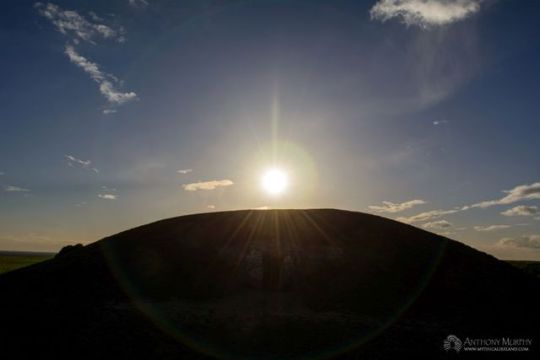

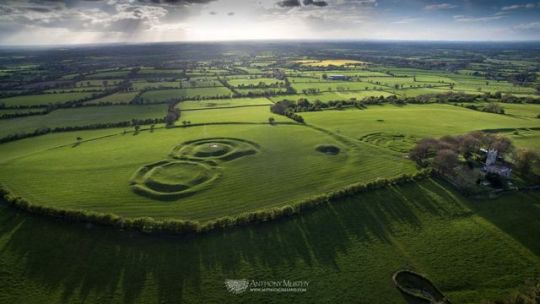
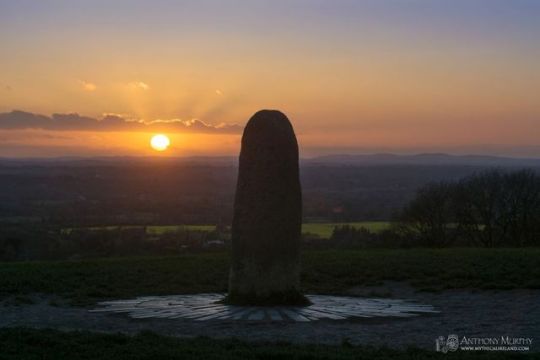
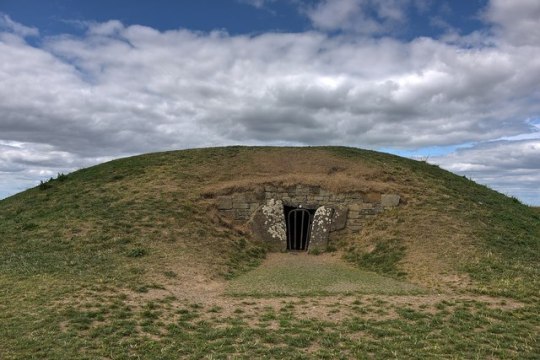

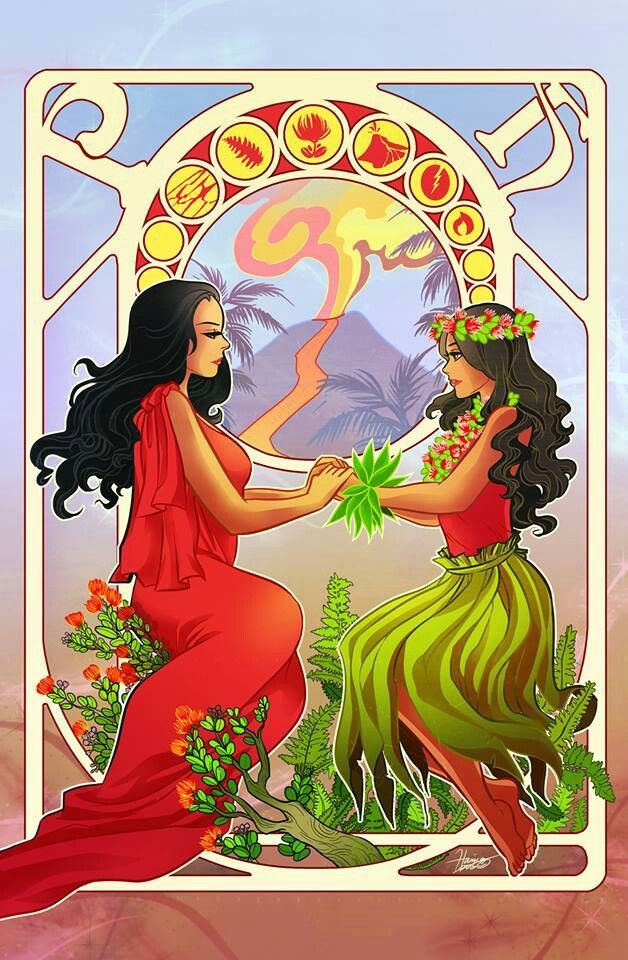
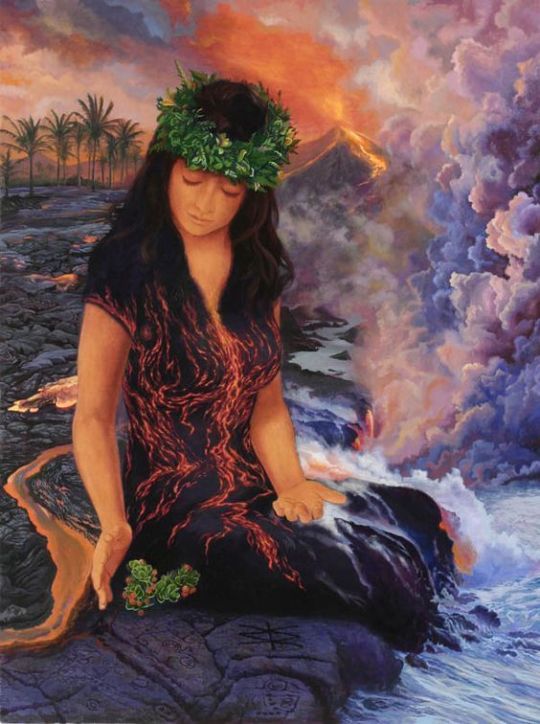
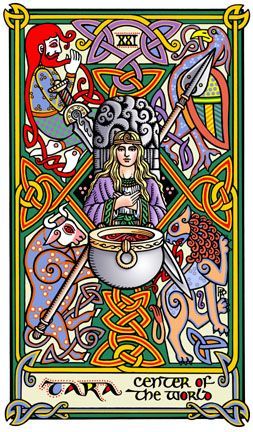
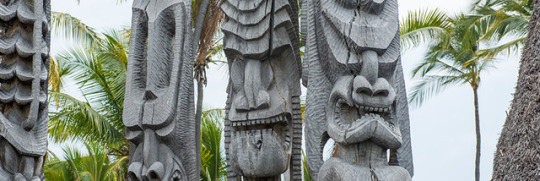
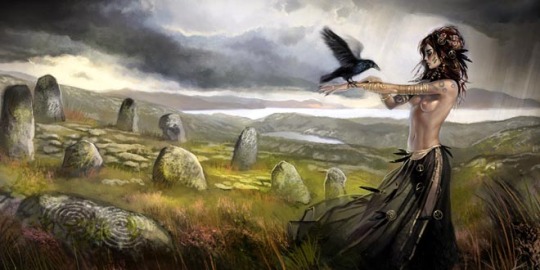
ANCIENT SITES | THE HILL OF TARA – TEAMHAIR
“The Hill of Tara, known as Temair in gaeilge, was once the ancient seat of power in Ireland – 142 kings are said to have reigned there in prehistoric and historic times. In ancient Irish religion and mythology Temair was the sacred place of dwelling for the gods, and was the entrance to the otherworld. Saint Patrick is said to have come to Tara to confront the ancient religion of the pagans at its most powerful site.”

“One interpretation of the name Tara says that it means a "place of great prospect" and indeed on a clear day it is claimed that features in half the counties of Ireland can be seen from atop Tara...Early in the 20th century a group of Israelites came to Tara with the conviction that the Arc of the Covenant was buried in on the famous hill. They dug the Mound of the Synods in search of the Arc but found only some Roman coins.”
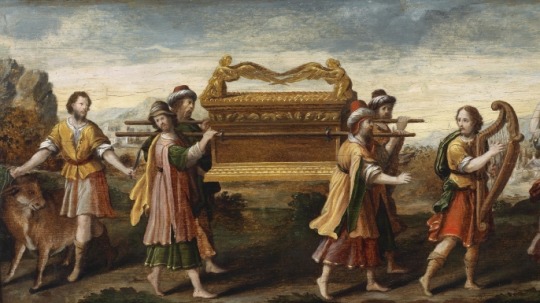
“Sitting on top of the King's Seat (Forradh) of Temair is the most famous of Tara's monuments - Ireland's ancient coronation stone - the Lia Fail or "Stone of Destiny", which was brought here according to mythology by the godlike people, the Tuatha Dé Danann, as one of their sacred objects. It was said to roar when touched by the rightful king of Tara.”
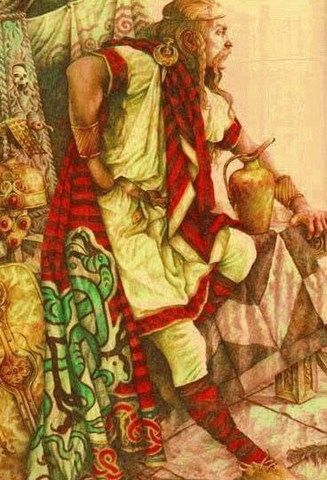
“In the churchyard at Tara there are two standing stones, which are believed to be ancient – remnants of a time when there were many stone monuments on Tara. The taller of the two stones is thought to feature a figure of the Celtic fertility god Cernunnos, and is similar to many of the 'Sheela na Gig' representations found across Ireland. These stones may date to the Neolithic period, although are more likely to have their origin in the Bronze Age.”
(via Mythical Ireland | Ancient Sites | The Hill of Tara – Teamhair)
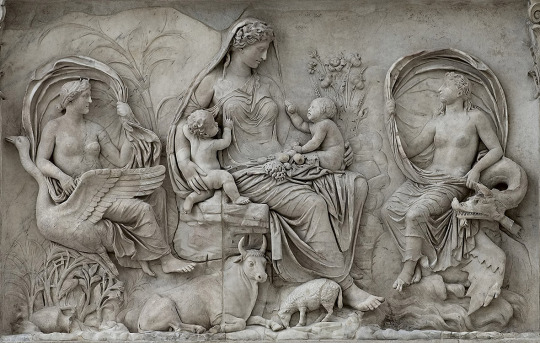
Terra (mythology)
“In ancient Roman religion and myth, Tellus Mater or Terra Mater ("Mother Earth") is a goddess of the earth...She is regularly associated with Ceres in rituals pertaining to the earth and agricultural fertility...Her Greek counterpartis Gaia...the Terra Mater who appears during the reign of Augustus is a direct transferral of the Greek Ge Mater into Roman religious practice...The word tellus, telluris is also a Latin common noun for "land, territory; earth," as is terra, "earth, ground"...In several modern Romance languages, terra (or French terre) is the name of planet Earth. Following post-classical Latin astronomical terminology, Earth is sometimes referred to as "Terra".”
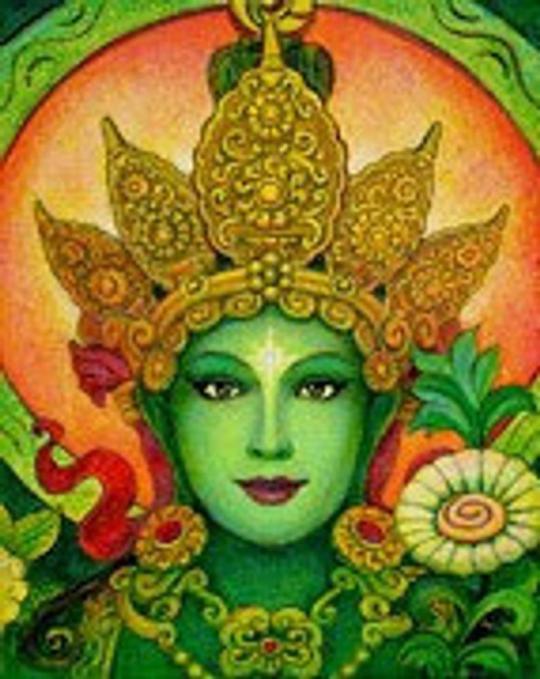
Tara (Buddhism)
“Tara, Ārya Tārā, or White Tara...in Tibetan Buddhism, is an important figure in Buddhism. She appears as a female bodhisattva in Mahayana Buddhism, and as a female Buddha in VajrayanaBuddhism. She is known as the "mother of liberation", and represents the virtues of success in work and achievements. She is known as Tara Bosatsu in Japan, and occasionally as Duōluó Púsà in Chinese Buddhism.
Tārā is a meditation deity worshiped by practitioners of the Tibetan branch of Vajrayana Buddhism to develop certain inner qualities and to understand outer, inner and secret teachings such as karuṇā (compassion), mettā (loving-kindness), and shunyata (emptiness). Tārā may more properly be understood as different aspects of the same quality, as bodhisattvas are often considered metaphors for Buddhist virtues.
Tārā is also known as a saviouress, as a heavenly deity who hears the cries of beings experiencing misery in saṃsāra. Whether the Tārā figure originated as a Buddhist or Hindu goddess is unclear and remains a source of inquiry among scholars. Mallar Ghosh believes her to have originated as a form of the goddess Durga in the Hindu Puranas.”
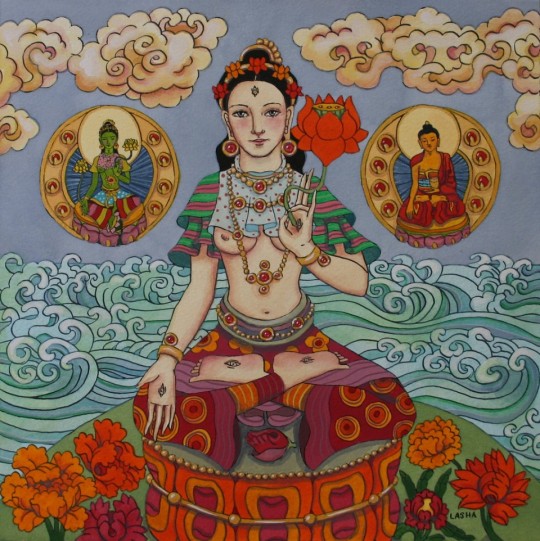
”She eventually came to be considered the "Mother of all Buddhas," which usually refers to the enlightened wisdom of the Buddhas, while simultaneously echoing the ancient concept of the Mother Goddess in India.
Independent of whether she is classified as a deity, a Buddha, or a bodhisattva, Tārā remains very popular in Tibet (and Tibetan communities in exile in Northern India), Mongolia, Nepal, Bhutan, Sikkim and is worshiped in a majority of Buddhist communities throughout the world.
Today, Green Tara and White Tara are probably the most popular representations of Tara. Green Tara (Khadiravani) is usually associated with protection from fear and the following eight obs-curation: lions (= pride), wild elephants (= delusion/ignorance), fires (= hatred and anger), snakes (= jealousy), bandits and thieves (= wrong views, including fanatical views), bondage (= avarice and miserliness), floods (= desire and attachment), and evil spirits and demons (= deluded doubts).”

”As one of the three deities of long life, White Tara (Saraswati) is associated with longevity. White Tara counteracts illness and thereby helps to bring about a long life. She embodies the motivation that is compassion and is said to be as white and radiant as the moon.
Tārā's name literally means "star" or "planet", and therefore she is associated with navigation and travel both literally and metaphorically as spiritual crossing to the 'other side' of the ocean of existence (enlightenment). Hence she is known literally as "she who saves" in Tibetan. In the 108 Names of the Holy Tara, Tara is 'Leader of the caravans ..... who showeth the way to those who have lost it' and she is named as Dhruva, the Sanskrit name for the North Star.”
Tārā also embodies many of the qualities of feminine principle. She is known as the Mother of Mercy and Compassion. She is the source, the female aspect of the universe, which gives birth to warmth, compassion and relief from bad karma as experienced by ordinary beings in cyclic existence. She engenders, nourishes, smiles at the vitality of creation, and has sympathy for all beings as a mother does for her children.”
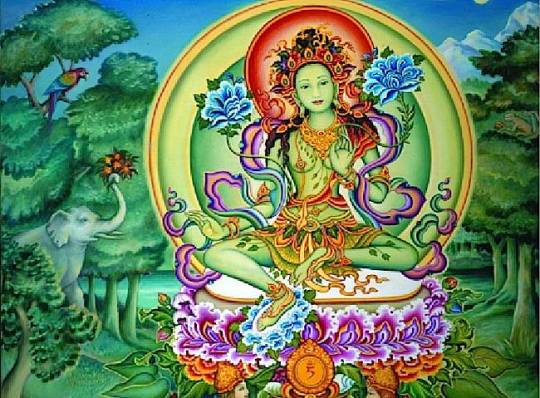
“As Green Tārā she offers succor and protection from all the unfortunate circumstances one can encounter within the samsaric world. As White Tārā she expresses maternal compassion and offers healing to beings who are hurt or wounded, either mentally or psychically. As Red Tārā she teaches discriminating awareness about created phenomena, and how to turn raw desire into compassion and love. As Blue Tārā (Ekajati) she becomes a protector in the Nyingma lineage, who expresses a ferocious, wrathful, female energy whose invocation destroys all Dharmic obstacles and engenders good luck.
Another quality of feminine principle which she shares with the dakinis is playfulness...Tārā is frequently depicted as a young sixteen-year-old girlish woman. She often manifests in the lives of dharma practitioners when they take themselves, or the spiritual path too seriously. There are Tibetan tales in which she laughs at self-righteousness, or plays pranks on those who lack reverence for the feminine. In Magic Dance: The Display of the Self-Nature of the Five Wisdom Dakinis...her playful mind can relieve ordinary minds which become rigidly serious or tightly gripped by dualistic distinctions. She takes delight in an open mind and a receptive heart then. For in this openness and receptivity her blessings can naturally unfold and her energies can quicken the aspirants spiritual development.”
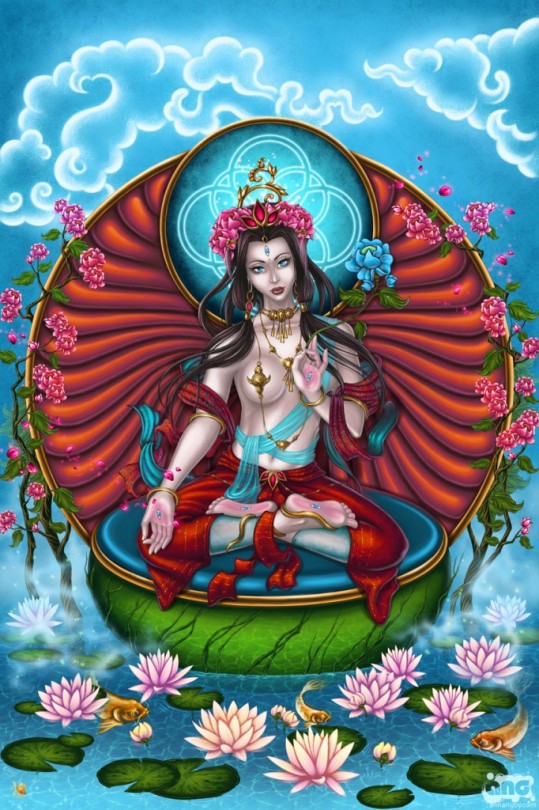
Polynesian narrative
“The Polynesian narrative or Polynesian mythology encompasses the oral traditions of the people of Polynesia, a grouping of Central and South Pacific Ocean island archipelagos...Prior to the 15th century AD, Polynesian peoples fanned out to the east, to the Cook Islands, and from there to other groups such as Tahiti and the Marquesas. Their descendants later discovered the islands from Tahiti to Rapa Nui, and later Hawai‘i and New Zealand. Latest research puts the settlement of New Zealand at about 1300 AD.”

”In some island groups, help is of great importance as the god of the sea and of fishing. There is often a story of the marriage between Sky and Earth; the New Zealand version, Rangi and Papa, is a union that gives birth to the world and all things in it. There are stories of islands pulled up from the bottom of the sea by a magic fishhook, or thrown down from heaven. There are stories of voyages, migrations, seductions and battles, as one might expect. Stories about a trickster, Māui, are widely known, as are those about a beautiful goddess/ancestress Hina or Sina.
In addition to these shared themes in the oral tradition, each island group has its own stories of demi-gods and culture heroes, shading gradually into the firmer outlines of remembered history. Often such stories were linked to various geographic or ecological features, which may be described as the petrified remains of the supernatural beings.”
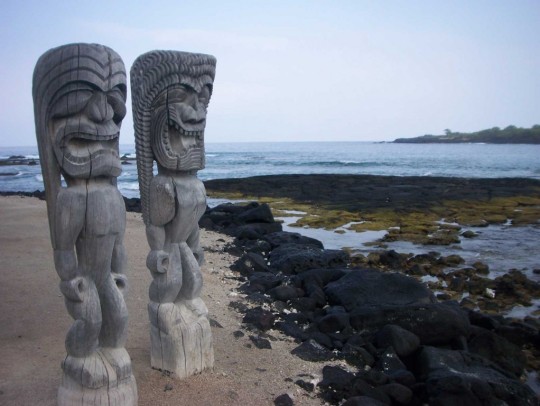
Tiki
“In Māori mythology, Tiki is the first man created by either Tūmatauenga or Tāne. He found the first woman, Marikoriko, in a pond; she seduced him and he became the father of Hine-kau-ataata. By extension, a tiki is a large or small wooden or stone carving in humanoid form...In some West Coast versions, Tiki himself, as a son of Rangi and Papa, creates the first human by mixing his own blood with clay, and Tāne then makes the first woman. Sometimes Tūmatauenga, the war god, creates Tiki. In another story the first woman is Mārikoriko. Tiki marries her and their daughter is Hine-kau-ataata. In some traditions, Tiki is the penis of Tāne. In fact, Tiki is strongly associated with the origin of the reproductive act.“
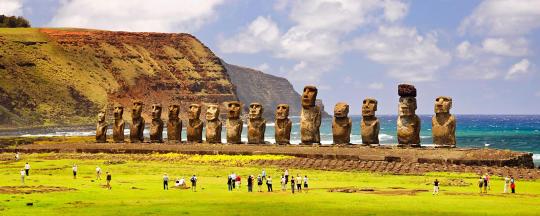
“In one story of Tiki among the many variants, Tiki was lonely and craved company. One day, seeing his reflection in a pool, he thought he had found a companion, and dove into the pool to seize it. The image shattered and Tiki was disappointed. He fell asleep and when he awoke he saw the reflection again. He covered the pool with earth and it gave birth to a woman. Tiki lived with her in serenity, until one day the woman was excited by an eel. Her excitement passed to Tiki and the first reproductive act resulted.
The word appears as tiki in New Zealand Māori, Cook Islands Māori, Tuamotuan, and Marquesan; as tiʻi in Tahitian, and as kiʻi in Hawaiian...In the Cook Islands...Tiki is the guardian of the entrance to Avaiki, the underworld...The entrance to Avaiki (the underworld) is called ‘the chasm of Tiki’.”
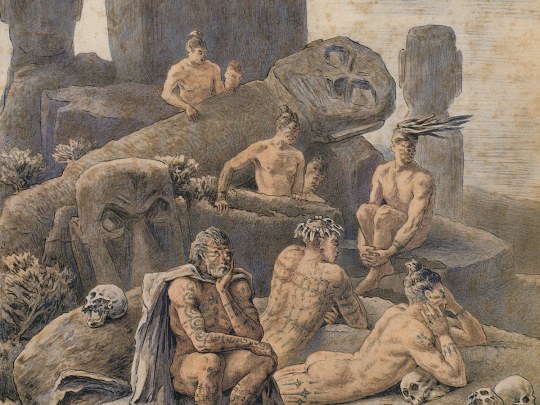
What Is the Meaning of Tiki statues?
“Tiki statues were originally carved by members of the Maori tribe as boundary markers for sacred grounds. The name of the statues is derived from the Maori name for the first human male, though the statues most often represent deities. With the introduction of missionaries into Hawaiian society in the early 1800s, Christianity became the dominant religion. Tiki statues have since lost much of their original meaning aside from their historical significance.”
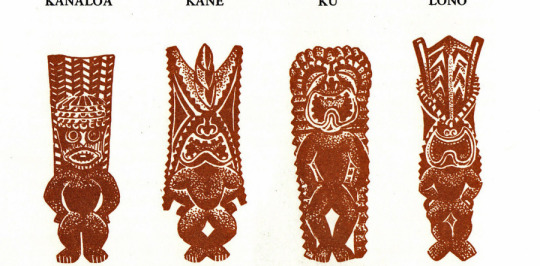
“The statues most commonly represent one of the four significant gods in Hawaiian culture: Kane, Ku, Lono and Kanaloa. Kane is considered the creator of the universe and the ruler of the natural world. Ku is the Hawaiian god of war...Lono is the god of rain and fertility, as well as music and peace. Kanaloa is the god of the sea...A Lono statue is identified by its large, “fertile” belly and jovial smile.
The Ki'i statue at Pu'uhonua o Honauna National Historical Park is one of the largest and most visited Tiki statues in Hawaii. The statue rests at the entrance of a recreated Maori village. The statue is of Tiki, the first human, which explains its humanoid appearance.”

Ti'iti'i
“In Samoan legend, the mythological figure Ti'iti'i appears in legends very similar to those recounting the tales of the demigod Māui, found in other island cultures. In one such legend, which is almost identical to the New Zealand fire myth of Māui, he succeeds in bringing fire to the people of Samoa after a battle with the earthquake god, Mafui'e.
In Polynesian spellings, 't' and 'k' are linguistically linked, and in speech, the 'k' sound is typically used in place of the 't' sound. Likewise, the apostrophe can be used to replace either sounds. Thus, the Samoan Ti'iti'i is comparable to the Gilbert Islands' Tiki-tiki, or Hawai'ian Maui-ki'i-ki'i.”
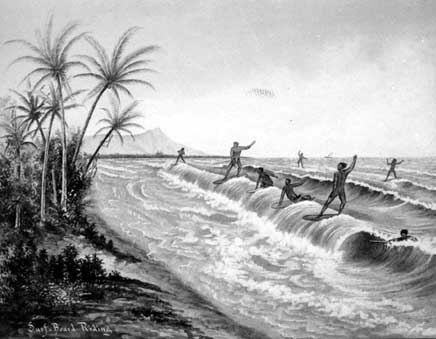
Rangi and Papa
“In Māori mythology the primal couple Rangi and Papa (or Ranginui and Papatūānuku) appear in a creation myth explaining the origin of the world...In some South Island dialects, Rangi is called Raki or Rakinui...are the primordial parents, the sky father and the earth mother who lie locked together in a tight embrace. They have many children...
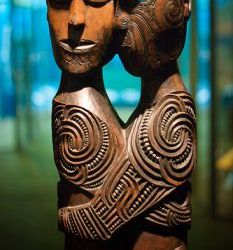
“Ranginui
Rangi ("Sky")
Raki ("Sky") in the South Island
Ranginui ("Great Sky")
Rangi-pōtiki ("Rangi the Lastborn"): possibly another name of Rangi, or a closely allied deity”
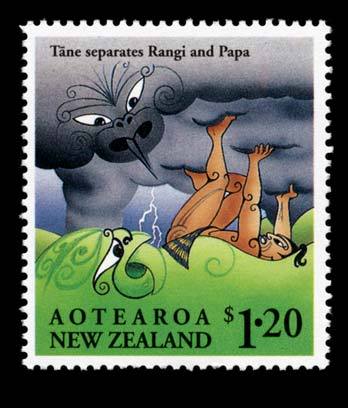
”Papatuanuku
Papa ("world")
Papatūānuku ("world separated"), (Earth), (Mother Earth)
Atea, husband of Papa (primordial parents) in Tuamotuan, Rarotongan and Marquesas genealogies
Wākea, husband of Papa, from Hawaii
Vatea, husband of Papa, father of gods and men in Mangaia, Cook Islands
Anu and Ki, Sumerian deities similar to Rangi and Papa
Uranus and Gæa, Greek deities similar to Rangi and Papa
Dyaúṣ-pitṛ and Pṛthvī-mātṛ, Vedic deities similar to Rangi and Papa”
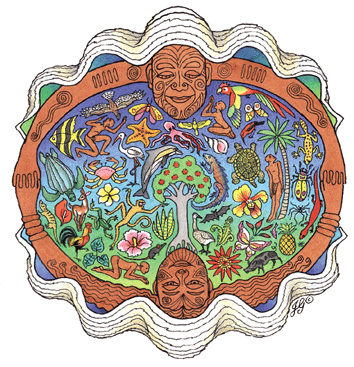
Hawaiian religion
“Hawaiian religion encompasses the indigenous religious beliefs and practices of the Native Hawaiians. It is polytheistic and animistic, with a belief in many deities and spirits, including the belief that spirits are found in non-human beings and objects such as animals, the waves, and the sky.Hawaiian religion originated among the Tahitians and other Pacific islanders who landed in Hawaiʻi between 500 and 1300 AD.”
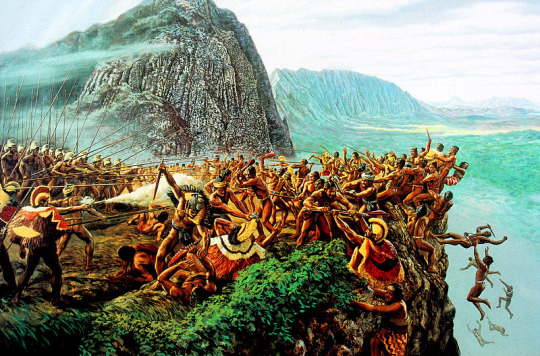
“One Hawaiian creation myth is embodied in the Kumulipo, an epic chant linking the aliʻi, or Hawaiian royalty, to the gods...After the birth of Laʻilaʻi, the woman, and Kiʻi, the man, the man succeeds at seducing and reproducing with the woman before the god Kāne has a chance, thereby making the divine lineage of the gods younger than and thus subservient to the lineage of man. This, in turn, illustrates the transition of mankind from being symbols for the gods (the literal meaning of kiʻi) into the keeper of these symbols in the form of idols and the like. The Kumulipo was recited during the time of Makahiki, to honor the god of fertility, Lono.”
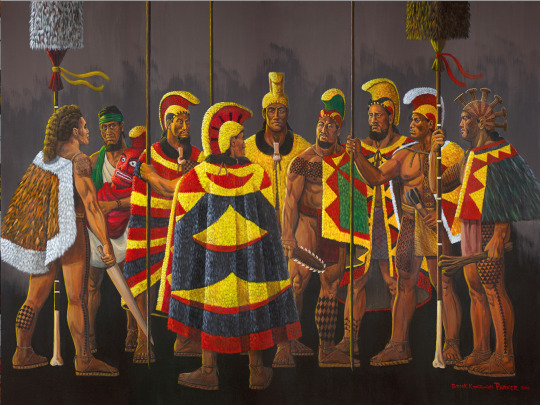
THE HOME OF THE ANCESTORS
“The ancestors of the New Zealand Maoris have a definite ancestral home from which they came to New Zealand. This bears the name Hawaiki which is the same as Hawai'i...The Hawaiians, however, had one word for all outside lands. This was Kahiki or Tahiti. If any one sailed to any far-away place, east or west, he went to Kahiki...Ke-alohi-lani (the shining or glorious heaven) was the where the vivid imagination placed all things beautiful. It was the ancient land to be desired. Another interpretation, however, makes it the land of shining clouds, probably lit by volcanic fires, reflecting the glory of the burning flames.”
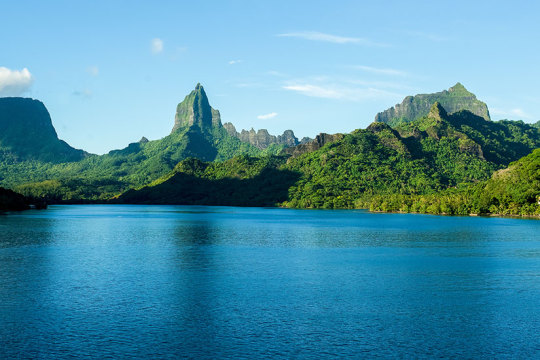
Hawaiki
“Hawaiki is the traditional Māori place of origin. The first Māori are said to have sailed to New Zealand from Hawaiki. And in Māori mythology Hawaiki is the place where Io, the supreme being, created the world and its first people...Hawaiki represents all that is good and powerful. It is a mystical place, where people turn into birds or descend to the underworld...In some traditions, the supreme being Io created Hawaiki. The gods are believed to live there, including the trickster demigod Māui, whose deeds are famous throughout Polynesia. The first woman, Hineahuone, was fashioned from the soil of Hawaiki.”
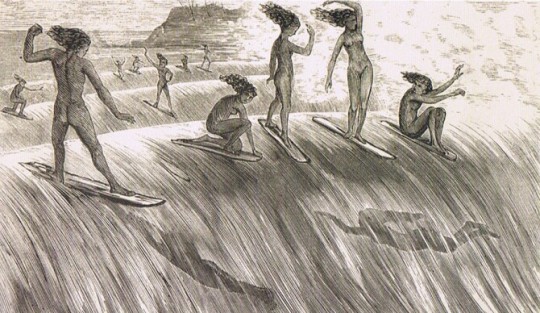
“S. Percy Smith...In his book Hawaiki, the original homeland of the Maori (1904), Smith advanced his theories as to the physical location of Hawaiki. He suggested that islands such as Savai‘i in Samoa, Hawaii and even Java near Indonesia were actually Hawaiki in localised forms...Some writers went further, arguing that Māori origins could be found in India and even Mesopotamia, the ancient region of present-day Iraq. Alfred K. Newman’s Who are the Maoris? (1912) is an example of a work that argues for the Indian origins of Māori people.”
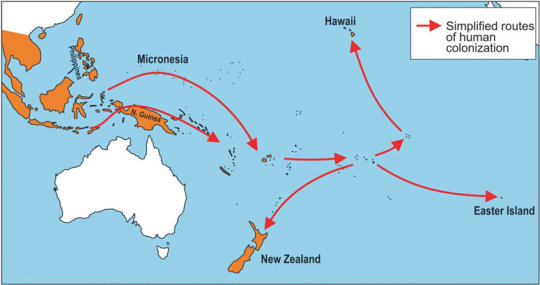
(via Hawaiki | Te Ara: The Encyclopedia of New Zealand)
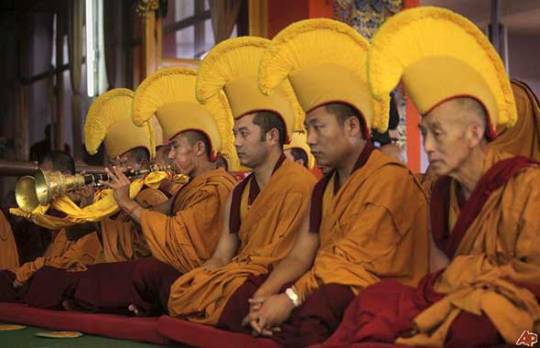
#hilloftara#irishgoddess#stpatrick#terramater#motherearth#buddhistgoddesstara#mothergoddess#fertilitygod&godess#polynesianislands#rangi&papa#tiki#hawaiki#tiitii#kiikii#tahiti#kahiki#kii&lailai#1stman&woman#hawaiianmythology
0 notes
Photo

#KennyandHeatherGoToBoraBora #TikiMan #FertilityGod (at InterContinental Tahiti Resort)
0 notes
Photo

Day 4 of 14 for days of love deities #freyr #lovegod #fertilitygod #virile #nordicgod. The Nordic god Freyr, twin to Freya, was the god of male sexuality and fertility and this is his virile form as I wanted to show him #aesir #vanir #vikings
0 notes
Note
When do you think you will update your fertilitygod fic? I’m waiting so patiently 😊 Also, Happy Mother’s Day! 💓
No idea really. I haven't had the time or motivation to even open the file in the last month or so. But next Sunday and Monday my husband got me a hotel room so I can drink and try writing so we'll see what I can plow through then
2 notes
·
View notes
Photo

My mood for the second half of this week. Kokopelli party. Kokopelli is a fertility deity for indigenous tribes in the southwest. This deity presides over both childbirth and agriculture. He is also known as trickster god and represents the spirit of music. . . . . . #kokapelli #flute #music #kokopelliparty #celebratelife #fertilitygod #trickstergod (at Phoenix, Arizona) https://www.instagram.com/p/CKWcvRInNjT/?igshid=iofaxr1wg49h
0 notes
Note
i don't know if you're still tagging but can i ask to be tagged in the FertilityGod!/Cernunnos Seb fic?? if not then it's no big deal lol, thank you
Certainly! Thanks for asking!
1 note
·
View note